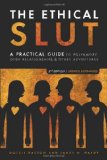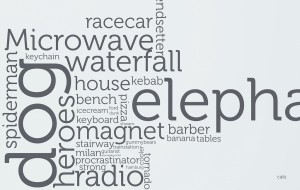I’m reading The Ethical Slut, 2nd edition and encouraging others to read and discuss it with me. If you have’t read it yet, you might want to should start with the Introduction to the series. The first installment of this read-along gave personal background about the author. In this part, we will examine Chapter 1, “Who Is An Ethical Slut?“
“Many people dream of having an abundance of love and sex .. Some believe that such a life is imossible and settle for less. … A few, though, persist and discover that being openly loving, intimate, and sexual with many people is not only possible but can be more rewarding than they ever imagined.” -From the opening of The Ethical Slut

Welcome to the beginning of the actual read-through. We’re just looking at the first, very short chapter today so if you’re still swamped with holiday madness you can easily catch up after the New Year. However, I’m thrilled that some of you are joining me now and look forward to your comments.
I want to welcome everyone to this read-along who is interested in the book or any of the topics it covers. This includes both the actively polyamorous, the strictly monogamous and everyone in between. This book is also extremely queer friendly, written by two queer authors who are open to non-traditional relationships in any configuration of people and gender identities. I even want to welcome people who’ve never read the book but have experiences of their own to share.
The first chapter of The Ethical Slut lays out a lot of the book’s core concepts and assumptions, including important details about the language it uses — especially loaded words like ‘slut’ itself. In some ways it works as a miniature manifesto toward reclaiming not only this word, but also other loaded but delicious and useful words like cock, cunt, and fuck. Lanaguage is the core of communication, which is the core of any relationship. As the authors point out, when you are considering relationships outside the norm the first step is to define your terms.
Defining your terms can be important in relationships themselves as well as books. I’ve experienced it several times in my own life where misunderstandings arose from words that meant different things to different people and were often cleared up after a discussion of language. Effectively, any relationship needs to establish a shared vocabulary and this is a lot of what Chapter 1 does with its readers.

The word slut is an especially interesting one. Since the publication of the first edition of this book, and as its become the “bible” of polyamory and non-monogamy, many people in sex-positive culture have taken up the cause of reclaiming the word from its negative connotations. There’s a thriving movement against “slut shaming” — people working against the idea that someone should be judged negatively because they choose to be sexually free.
In my experience, slut is at that strange mid-point between acceptance and insult, where its acceptability depends entirely upon context. The idea of being attacked for our high sexual appetites or our decision to practice multiple relationships is not an abstract one to many of us; slut shaming is something far too many of us have experienced personally, and painfully in our lives — as my friend Kiki Christie recently wrote about in her blog. Entire books have even been written about the impact of the negative use of the word slut on young women.
And yet amongst my fellow kinky, sex-positive freaks (another word I’ve reclaimed), ‘slut’ can be a term of love and respect. Slut is a term of friendship, respect, and friendly sharing of another’s pleasure in sexual adventure. Amongst the sex-positive, and the fans of this book, slut is not gendered either. If a lover says to me ‘you slut!’ I would smile, give him or her a kiss, and call them sluts right back.
One phrase that jumped out at me from the ‘slut manifesto’ section of this chapter was the following statement: “sluts qualify for mortgages like everyone else.” I think it’s important to remember that some sluts do face discrimination, deliberate or otherwise. When I lived with a lover and her other partner in College Station, Texas and the neighboring town of Bryan, there were laws limiting the number of unrelated, unmarried adults living in a home. This was designed to limit where students could live, but also had the side effect of making it more difficult for our threesome to find a home.
Some of you may be interested in the differences between the two versions of the book, and this chapter has a brief outline of the differences — more exercises for the reader to do as they read are promised, which seems like a positive change.
One of the first differences a reader may notice is an apparent change in authorship. Dossie Easton returns unchanged from the first edition, but Catherine A Liszt is replaced with Janet W. Hardy. Except, as this chapter explains, Liszt was merely Hardy’s pen name which she used until her children were grown and has since discarded.
Speaking of language, the first chapter of this book now directly addresses the word polyamory. Polyamory as a word was only 7 years old when the first edition of the Ethical Slut was published. As the authors say: “Polyamory has moved into the language so rapidly that we think maybe the language has been waiting for it a very long time.” They also point out that words such as non-monogamy and open relationships define themselves by what they aren’t, whereas polyamory is defines itself by what it is.
Polyamory has become a loaded term in its own right, in my opinion. While there are many fantastic poly activists (the authors among them) as in many other subcultures some less restrained zealots have flavored the word for others who may now choose to avoid the word. Others avoid calling themselves polyamorous because they feel like their personal definition of the word doesn’t match how they personally practice non-monogamy. It’s important to recognize that for all that ‘polyamory’ can function as an umbrella term reflecting all manner of relationships, there are many who would never identifying with the term. My favorite subculture, the Burning Man community, is full of people practicing all kinds of non-traditional relationships, yet there are relatively few who would openly use the label. On my previous read-throughs, I always felt like the Ethical Slut had a lot to offer people in all kinds of relationships, but I’ll be interested to see if I feel like this is still true after this reading.
In the next chapter of the book, the authors examine some myths about sluts and a number of other words associated with the term like “promiscuous.” Our read-along will continue on Thursday, January 6th, 2011.
So now I’d like to open things up to our first discussion about the book itself. If you’re reading along with me I’d like to hear your reactions. And tell me, what does slut mean to you? How does the culture around you — the one you’ve chosen to associate with — handle your relationship choices? Please comment — even anonymous comments are welcome though I hope you’ll consider leaving at least a name or pseudonym to call you by.